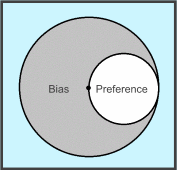Introduction to the
Matter of Bias
What is it, why do we care about it,
and what can we do about it?

We've
narrowed it down -
This can be a big topic, so
we've narrowed it down a little. First off,
we're talking about something pertaining to the individual which
is usually referred to as "mental
bias," a psychological phenomenon that occurs in the mind.
So we're NOT talking about angles, or electricity, or any of that
kind of stuff. And we're not talking about something that
we only observe in others (though we often do), such as the media, or
pundits, or whomever.
What and
why we care: We're talking about a thing that happens to us
individually that can lead to possible distortions and errors in how we see
reality. And that's why we care about it here.
 Okay,
so here's a working definition:
Okay,
so here's a working definition:
A mental
bias is the human tendency to make systematic errors in certain
circumstances based on cognitive and emotional factors rather than evidence,
resulting in, or expressed as prejudice in favor of or against
one thing, person, or group compared with another, often in a
way considered to be unfair.
Psychologists, sociologists, political scientists and others
have identified and studied a range of different biases that
ultimately affect how we see reality. And biases can play
a big role in logical fallacies.
Frame Analysis: In 1974 Irving Goffman, a sociologist and
social psychologist, published Frame analysis: An essay on the
organization of experience. In a sense, this is how people
recognize patterns, both spatial and temporal. It looks at
various things, such as stereotypes and labels, as well as
images, metaphors, actors,
messages. Stereotypyes and labels are further discussed
as categories of pattern recognition on the page about the
neuropsychological basis for bias.
As it
happens, there is a neuropsychological basis for biases, one
that actually benefits us a great deal, and one that we can NOT
avoid. What we can do is understand it and take it into
account when we seek to perceive and understand reality.
Bias vs.
Preference:

As noted above a bias can be in
favor, or against. In that regard, it can involve a preference. In
other words, preferences can be considered to be biases. As
a result, what one person might see as a bias in another person, that
person may mostly experience it as a preference
 Preferring
vanilla ice cream over chocolate, or preferring not to see movies
containing violence, or preferring to associate with those who share the
same ethnic background.
Preferring
vanilla ice cream over chocolate, or preferring not to see movies
containing violence, or preferring to associate with those who share the
same ethnic background.
Negative Biases:
Given that a bias, while it may
include preference, is based on a degree of preconception and
evaluation, often absent accurate evidence, it can have a negative
consequence, especially when it is in a negative direction.

People on welfare are lazy, or women are too
emotional.
Eliminate Biases:
Can't be done. At the core of all "biases"
is the human brain's capacity to recognize patterns, both
physical and temporal. This can and does lead to biases
and stereotypes, both of which can accurate OR can be erroneous.
Pattern recognition is a good thing. It helps us in
dealing with the world around us. So we don't want to
eliminate it, just limit the ways in which it can lead to
counter-productive biases (those that are erroneous).
Use Critical Thinking Skills
So...given we can't and probably shouldn't
eliminate our ability/propensity to have biases, what do we do?
Well, one idea is not to stop them from occurring but stop them
from leading us to incorrect perceptions of reality. In
other words, constantly question what we think is true.
This is often called Critical Thinking. It is the backbone
of the Scientific Method, a way of accepting the presence of
biases but minimizing their power to distort.